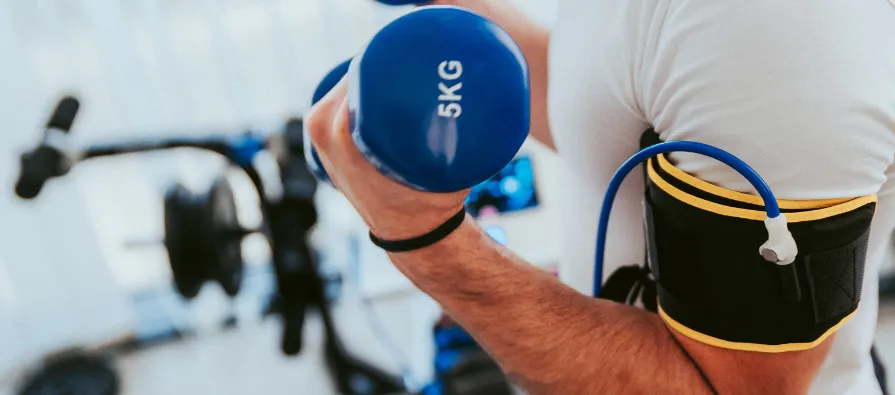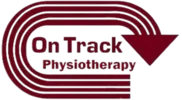On Track Physiotherapy
Blood Flow Restriction in Ann Arbor

Blood Flow Restriction Therapy at On Track Physiotherapy
Are you an athlete eager to regain your competitive edge after an injury? Or someone who wants to restore your strength and mobility so you can enjoy an active lifestyle again? If heavy lifting and high-impact training aren’t an option for you right now, blood flow restriction (BFR) therapy could be the breakthrough you’ve been waiting for.
At On Track Physiotherapy in Ann Arbor, our expert physical therapists offer BFR to help you rebuild muscle, increase strength, enhance performance, and meet your rehab goals safely. This innovative technique uses inflated cuffs to partially restrict blood flow to your limbs while you perform light resistance training. The resulting metabolic stress spurs muscle growth and strength development on par with heavy lifting—but with less weight, impact, and injury risk. Whether you’re 18 or 80, our personalized BFR therapy delivers results.
Unlock Strength and Muscle Without Heavy Lifting
BFR gives you the benefits of heavy lifting without having to actually lift heavy. By training while wearing inflatable cuffs on your upper arms or legs to moderately restrict blood flow, you create a temporary hypoxic state. This triggers a cascade of muscle-building metabolic stress, anabolic signaling, and cell swelling responses similar to training with high loads. So even while lifting 30-50% of your normal weight, you can achieve hypertrophy and strength gains comparable to lifting closer to 70% 1RM.
The beauty of BFR lies in this ability to use substantially less external load while realizing similar gains. This makes it an extremely useful technique for populations unable to safely lift heavy weights due to:
- Injuries
- Surgeries
- Osteoarthritis
- Joint replacements
- Muscle strains
- Tendonitis
- And more
BFR allows you to continue building strength even when heavy loads aren’t feasible or advisable. And since lighter loads are used, it’s a lower-impact form of resistance training that reduces joint stresses. Our therapists customize your BFR therapy to match your needs and goals. We help athletes return to sports stronger while empowering everyday people to regain function.
3 Life-Changing Benefits of Blood Flow Restriction Therapy
BFR techniques boost rehabilitation and fitness outcomes. Here are 3 major perks our client’s experience with this progressive therapy:
1. Dramatic Muscle and Strength Gains With Lower Weights
Numerous studies demonstrate substantial increases in muscle size and strength using BFR with just 20-30% 1RM loads. One review found an average strength gain of 22% and muscle growth of 9% over 6-10 weeks across various populations. Since lighter loads are used, BFR allows strength and hypertrophy boosts with less joint loading, pain, and injury risk. This makes it ideal after injuries, surgeries, or during early rehab when heavier training isn’t possible. The metabolic stress and anabolic signaling from BFR drive muscle growth and strength development similar to heavier lifting. So while the weights are lighter, the gains are still heavy-duty!
2. Fewer, Shorter & More Efficient Workouts
Due to the extreme metabolic demands induced, BFR enables people to achieve productive training cycles with fewer reps. One study found just one set of blood flow-restricted arm curls elicited protein synthesis equal to three standard sets. With BFR, sessions are shorter yet highly effective. In 20 minutes you can trigger substantial muscular and vascular adaptations typically requiring 60+ minutes of traditional training. This efficiency saves our clients time while optimizing gains. It’s easy to fit brief but intense BFR workouts into busy schedules.
3. Custom Programming for Different Goals and Abilities
From seniors looking to maintain strength and mobility to competitive athletes striving for peak performance, BFR methods work. Our certified clinicians design personalized programs tailored to each client’s:
- Diagnoses
- Recovery status
- Goals
- Fitness level
- And more
We continually adjust your plan based on progress assessments and feedback. This comprehensive approach makes BFR therapy effective and safe over the long term. Whether aiming to regain function after knee surgery or training for your next Ironman, we develop custom BFR protocols to meet your needs. This sets our clients up for success at every stage.
BFR Therapy FAQs
If you’re intrigued yet still have some questions about blood flow restriction methods, you’re not alone. Many people wonder:
- How Does Restricting Blood Flow Help Healing and Strength Building?
BFR’s effectiveness stems from the hypoxic environment created by moderate blood flow restriction during exercise. With oxygen delivery momentarily reduced, fast fatigue sets in quickly even when lifting just 20-30% 1RM loads. This prompts localized metabolic stress similar to lifting heavier near maximal capacity. Hormones, metabolites, and swelling signal the muscles to grow and strengthen despite using lowered external resistance. By tricking your body into thinking it’s lifting heavier weights than it really is, substantial adaptations occur. And since lighter loads are used, it’s a lower-impact way to realize gains.
- What Are the Risks?
The precise equipment and protocols used ensure that BFR is extremely safe. That said, there are contraindications for certain populations at higher risk of adverse effects.
We thoroughly screen clients to determine appropriateness. Our therapists are specially trained in the safe, gradual application of BFR and monitoring tolerance. Still, it’s crucial to only utilize BFR under professional guidance. Improperly restricting blood flow for too long or too intensely can potentially lead to nerve injury or dangerous systemic effects. But when applied correctly, it’s highly effective and low risk.
- What Happens if You Restrict Blood Flow For Too Long?
Our therapists carefully control BFR duration based on your needs. Restriction is only applied during exercise itself, not prolonged periods. Between sets, cuffs are deflated to restore circulation. Session length varies from 15-20 minutes for beginners and up to 45 minutes for advanced athletes. Going beyond these timeframes can overwhelm localized tissue oxygenation and waste clearance processes. Excessive restriction can also cause nerve irritation and pain. But our clinically backed protocols prevent these risks while maximizing your results.
Restore Your Strength and Confidence
If pain, mobility limitations, or muscle loss are keeping you from an active life right now, BFR could help turn things around. On Track Physiotherapy’s therapists offer unmatched expertise in smart, progressive BFR programming. We empower you to rebuild strength efficiently so you can enjoy exercise and sports again safely.
Schedule a Consultation With Our BFR Specialists Today!
During your first visit, we’ll assess your status, goals, and needs. Then we’ll customize a plan to help you:
- Regain strength after an injury
- Return to training stronger post-surgery
- Build muscle with less pain or impact
- And more
With science-backed BFR techniques from our compassionate, motivating team, you CAN reclaim your active lifestyle. We’re ready when you are. Reach out now to get started!
About the Author
Dr. Greg Schaible ignites movement in patients needing Certified Strength & Conditioning and Sports Rehab. His years of dedication unlock physical potential for a better quality of life. At On Track Physiotherapy in Ann Arbor, Dr. Greg Schaible wields a patient-centered approach, wielding cutting-edge techniques and bespoke care plans to conquer a vast array of physical challenges.


